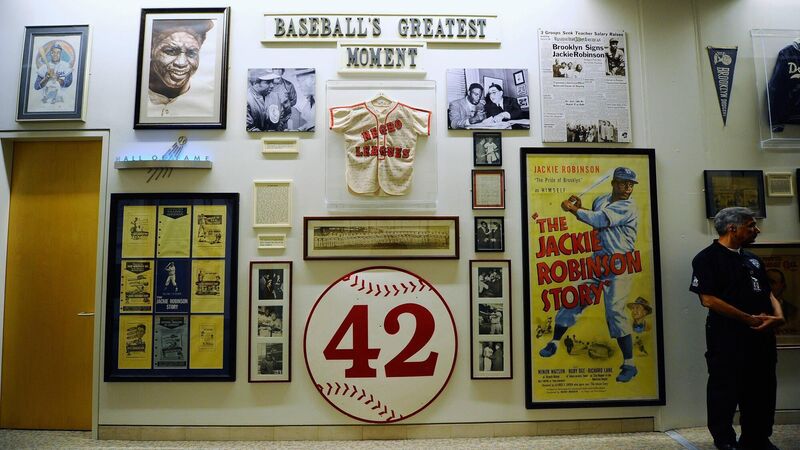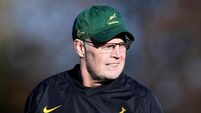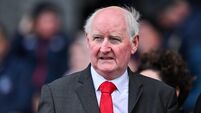John Riordan: Brooklyn and the US unite for Jackie Robinson Day

75 years ago today, Jackie Robinson wore 42 for the Brooklyn Dodgers at Ebbets Field for the first time, becoming the first Black man to play in a league that had up until then segregated players of African descent away from its ballparks.
The number 42 holds special significance in the history of the GAA and, even more significantly, in the history of Major League Baseball.
Rule 42 was amended almost 20 years ago and paved the way for the unforgettable Six Nations visit of England to Croke Park in early 2007. Although it was a movement of wording and wrangling and hand wringing, it ultimately represented an opening out of attitudes and a break from the past.
75 years ago today, Jackie Robinson wore 42 for the Brooklyn Dodgers at Ebbets Field for the first time, becoming the first Black man to play in a league that had up until then segregated players of African descent away from its ballparks.
That break from the past shattered an entire nation's view of civil rights - there was now a sizable enough number of Americans who no longer saw the sense of the races being divided. The battle had always been destined to be long and drawn out but who was going to be the first to put themselves forward as a figurehead?
Today, as with every April 15, all of baseball's almost 1,000 players will be lining out across the 15 arenas with the number 42 on their backs, a number which was retired from the sport in the late 1990s.
The last player to wear 42, the New York Yankees pitcher Mariano Rivera, had started his career before that commemorative changing of the rules and since his retirement in 2013, it is now never worn on any other day.
Robinson's era-defining debut happened four months before Cavan overcame Kerry to win the 1947 All-Ireland Football final at the Polo Grounds in Upper Manhattan, another baseball Mecca in another New York City borough which was also playing host to a historic first. The Polo Grounds did not lock out other codes as GAA grounds did (mostly) - football was played there and of course a previous incarnation of the stadium was a venue for the sport of Polo.
Both Ebbets Field and the Polo Grounds were demolished in the early 1960s, not long after their teams decamped to California to become the LA Dodgers and the San Francisco Giants, respectively.
Robinson didn't follow the Dodgers west because his career was on the wane just as rumours and fears of Brooklyn losing its team began to crystallise. He was physically a spent force when the Holy Grail of a first and only ever World Series was won by Brooklyn in 1955. Sadly, he didn't even get to play the decisive Game Seven that won it for the Dodgers against the Yankees.
It gets sadder still. His playing contract was dispensed with just before the borough lost its beloved team to LA and he cut ties with the club and the game not long after a muted season-long swansong at the Giants. He died young in the early 1970s at the age of 53, dedicating his final decade to the civil rights struggle while his body succumbed to a myriad of ailments often linked to the stresses of a uniquely high pressure career.
But that athletic fadeout should never take away from the great statistical achievements of a player who was almost 30 before he was permitted to perform on the biggest stage.
The injustice of that late arrival to a professional career is heightened by the widely held opinion of the time and to this day that, in his youthful prime, Robinson was regarded as the greatest all-around athlete in the country in the late 1930s.
He was a star running back at UCLA and he was a national collegiate long jump champion. Had war not broken out, he might have even shown the world how forceful he was - he had been destined for the 1940 Olympics in Tokyo. Instead he went off to serve.
After he finally got his move from the Negro Leagues to the Major Leagues, there was enough accomplished by the swashbuckling second baseman during the eight seasons that preceded '55 to ensure the risky experiment was a success, at least from a playing point of view. The sad reality was that when Dodgers owner Branch Rickey shoved Robinson out into the post-war spotlight, the team needed their newest player to be a baseball star, first and foremost. The cultural impact of the player was way down Rickey’s priority list.
Black athletes know all too well that they need to over perform in their chosen sport in order to meet their minimum requirements. It'll never be fully appreciated how much Robinson carried the weight of a race and a broken society into his first few seasons. Had he not broken records and helped his team win National League pennants, the cause of civil rights could have been set back dramatically.
Infamously, one of the problematic expectations placed on his shoulders was the requirement that he avoid answering back when the inevitable abuse of opponents rained down on him. He was good to his word in ‘47 and ‘48 and then all bets were off. A spikier Robinson emerged in 1949 just as other Black players began to enter the league in their droves. The Georgia-born pioneer had opened out possibilities for his peers and that was all fine and well. But there needed to be a meaner streak to his approach if he was to survive. Along with everything else baseball can deliver, score settling and retribution are hallmarks and almost beloved as traditions.
Robinson was, at that time, the king of the stolen base. He perfected the art of making the pitcher’s life a misery by sprinting from first to second without the ball having been hit. And when that risky maneuver is a staple of any player’s strategy, he must also be ready to dish out some knee high tackles at second, maximising the possibility of a successfully stolen base while also maybe even righting a wrong perpetrated by the opponent / victim during a previous game or a previous season.
It’s been a sad week for Brooklyn. On Tuesday, the morning commute was ruptured by a bizarre mass shooting carried out by an individual who sought to cause maximum chaos and fear on the subway. Thankfully nobody died and by that afternoon, commuters and life in general was back to normal for everyone fortunate enough not to have been on or near that train.
I’m like a broken record on these pages when I cite the power of sport to heal the undeniable fissures of this vast nation. It’s hard not to lose hope week after week when further depths are plumbed. It would be stubbornness of irresponsible proportions to think that a day where 42 is worn by well-paid athletes will right the wrongs of decades of injustice.
It would probably also be tiresome for Robinson himself to read the words of a white guy like me attempting to distill his achievements into a newspaper column, especially on a day built around the sort of ceremony he was averse to by the time his life was coming to a painful end.
But whatever the flaws of how he is acknowledged and remembered, the greatest power of what he did or was forced to do is the fact that other minority athletes and civil rights activists alike felt they could walk through the doorway he had opened up.
And if baseball taking a moment today means we can all do a little more to help unify Brooklyn and New York City and the US, then the powerful legacy of Jackie Robinson is worth more than he could have ever imagined.








